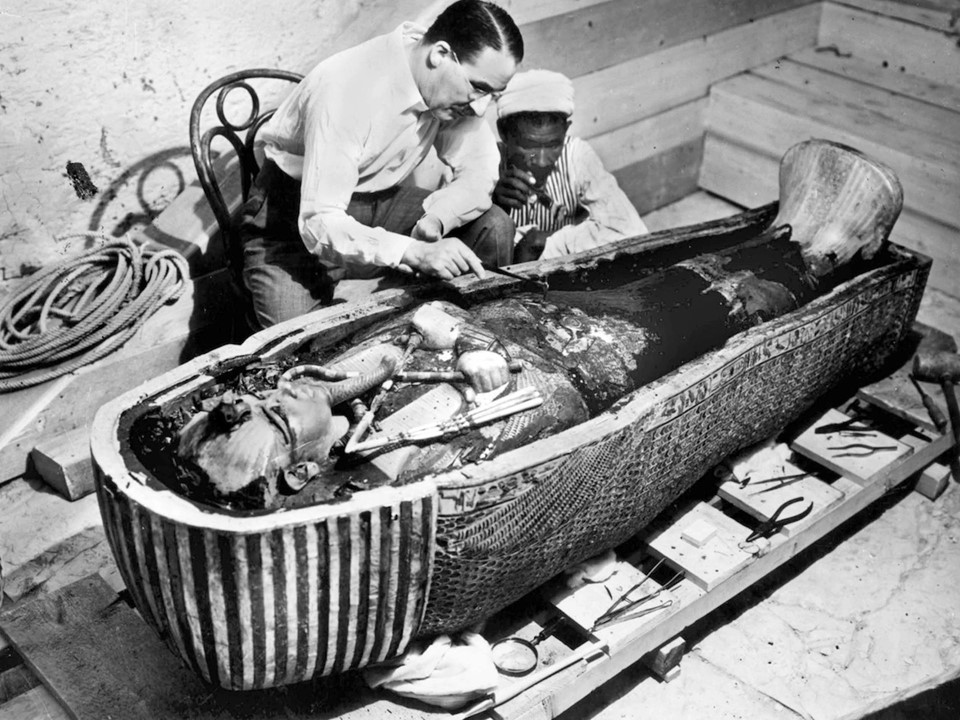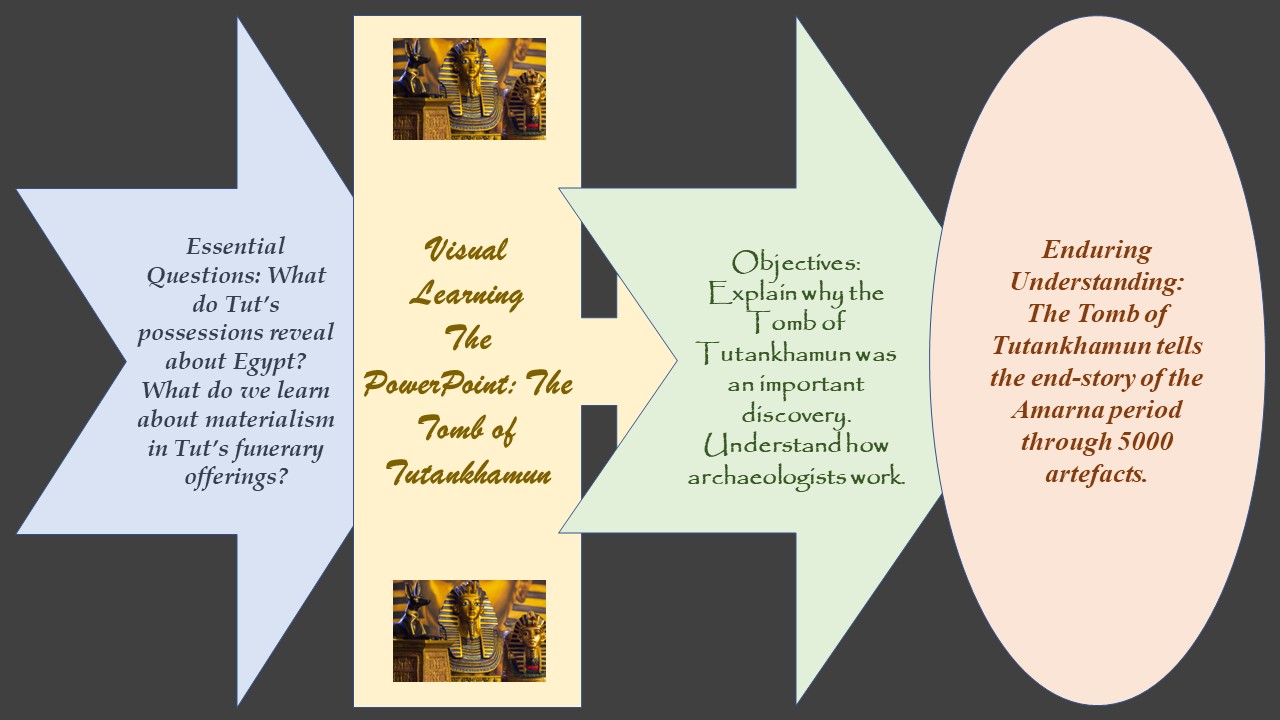
Howard Carter with Innermost Coffin of Tutankhamun photographed by Harry Burton, 1922 (Tutankhamun Archive, Griffith Institute, University of Oxford) https://www.khanacademy.org/humanities/ap-art-history/ancient-mediterranean-ap/ancient-egypt-ap/a/tutankhamuns-tomb
“It was sometime before one could see, the hot air escaping caused the candle to flicker, but as soon as one’s eyes became accustomed to the glimmer of light the interior of the chamber gradually loomed before one, with its strange and wonderful medley of extraordinary and beautiful objects heaped upon one another.” This is how Howard Carter, the archaeologist who discovered The Tomb of Tutankhamun describes the moments he first set eyes on the Pharaoh’s place of rest… At first, Carter continues, I thought I was looking at wall paintings; it was a moment before I realized I was seeing actual three-dimensional objects. Carnarvon, my patron, couldn’t bear it any longer. “Can you see anything?” he demanded… Yes, wonderful things… was all I could say! https://www.smithsonianmag.com/history/how-howard-carter-discovered-king-tuts-golden-tomb-180981052/
There is so much to explore… A PowerPoint (…please Click HERE!) presenting over one hundred artifacts will help us understand the ‘secrets’ of Tutankhamun’s Tomb, the story of its incredible discovery, and the beauty of the artifacts found inside. The Golden Mask of the Pharaoh, his Aton Throne, the Golden figure of Tutankhamun, the Harpooner, and the actual mummy, are just four of the over five thousand items discovered inside the Tomb… clues to our exploration and a path for exciting discoveries! Four answers to four questions… and our 4-Steps to Success Lesson Plan will keep us… on track!

Who was Tutankhamun? Tutankhamun was an Egyptian pharaoh who ruled during the 18th dynasty of ancient Egypt. He was born around 1341 BC, during the reign of his father, the pharaoh Akhenaten. He became pharaoh around the age of 9 or 10, reigned for around 10 years, and he died at the age of 18 or 19. The exact details of Tutankhamun’s life and reign are not well-known, as he was not a particularly powerful pharaoh during his lifetime. However, his tomb and its contents have provided valuable insights into the art, culture, and society of ancient Egypt during the New Kingdom period.
Was the reign of Tutankhamun important? If so, explain why or why not. Tutankhamun came to the throne at a young age, and his rule was short, lasting around ten years. He was the son of Akhenaton, the pharaoh who introduced a new religious system in which the god Aton was worshipped as the main deity, and the traditional Egyptian gods were largely eliminated. This significant departure from the established religious practices of ancient Egypt caused upheaval and destabilization during Akhenaten’s reign. While on the throne of Egypt, Tutankhamun chose to abandon the religious reforms introduced by his father and take steps toward the restoration of the traditional gods and religious practices of ancient Egypt. This religious decision was a key factor in bringing back stability to the country, and an important accomplishment of his reign.
Why was the discovery of the Tomb of Tutankhamun important? The discovery of the Tomb of Tutankhamun in 1922 by Howard Carter is considered important for several reasons. Firstly, the tomb was found almost completely intact, providing an unprecedented glimpse into the burial practices and beliefs of the ancient Egyptians. Additionally, the tomb contained a wealth of valuable artifacts, including a solid gold coffin, jewelry, and other grave goods. Finally, the discovery of the tomb helped to reignite global interest in Egyptology and continues to be an important cultural and historical discovery.
What do Tutankhamun’s funerary possessions reveal about Egyptian Art? The artifacts found in the tomb, such as the jewelry, statues, and furniture, provide insight into the materials and techniques used by ancient Egyptian artists and artisans. They also reflect the religious beliefs and practices of the time, as well as the status and wealth of the pharaoh buried in the tomb. Furthermore, the tomb provided a glimpse into the daily life of the Egyptian elite… their fashion, beauty products, and the importance of the afterlife in their culture. The artifacts from Tutankhamun’s tomb are also considered masterpieces of ancient Egyptian art, their quality, and preservation are considered unmatched.
For the New Kingdom, the Amarna Period, Timeline, please… Check HERE!
Enjoy Tutankhamun: The Truth Uncovered This documentary was produced by the Discovery Channel and aired in 2020. It presents new evidence and theories about the life and death of Tutankhamun, as well as the discovery of his tomb. https://www.youtube.com/watch?v=pI-1eZ2SiRs
Another Video about Tutankhamun’s Treasures by National Geographic… https://www.youtube.com/watch?v=-obKX-mqjXQ
A Khan Academy Presentation on Tutankhamun’s Tomb… https://www.khanacademy.org/humanities/ap-art-history/ancient-mediterranean-ap/ancient-egypt-ap/a/tutankhamuns-tomb